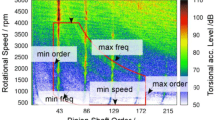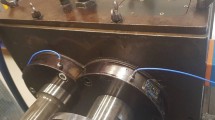Abstract
This article deals with the possibilities for reducing car gearbox vibration and noise in connection with the production quality of its parts on machine tools. The technical condition of these machine tools is monitored by vibration diagnostics. The article explains as well the method of gear pinion machining. The accuracy of manufacture, installation and adjustment of the gearbox mechanisms and the method of machining gearbox pinion (grinding or superfinishing) contribute significantly to the overall level of car gearbox vibration and noise. The location of gears and bearings has also a similar effect. The level of production, assembly and the superfinishing method in processing the gearbox pinion are shown in the vibration spectrum as affecting the reduction of gearbox noise and vibration.
Access provided by CONRICYT-eBooks. Download conference paper PDF
Similar content being viewed by others
Keywords
1 Introduction
The technical diagnostics of machines and equipment is mainly based on vibration measurements and analysis of all critical components of these machines for predefined operation conditions and at the stage of installation of the new machine and its subsequent operation. One of the possible noise sources in the car is the drive system, which includes the gearbox.
Frequency analysis of vibration spectra is a modern tool for the process of identifying the mechanical defects that affect the quality of production, assembly and overall noise in car gearboxes. The analysis of vibration spectra is performed using frequency analysis methods and means of technical diagnostics that monitor the influence of gears and rolling element bearings in a complex gearbox.
The article deals with the possibilities of reducing car gearbox vibration and noise in connection with various methods of machining the pinion (grinding, superfinishing) with bearing diameter 32h5 (see Fig. 1). The bearing is fitted to the diameter 32h5 without an inner ring, so that the cylindrical pin serves as the inner rolling surface of the bearing. The difference in machining a grinded and super-finished pinion is shown in Fig. 2.
2 Measurements Analysis
On the stand (see Fig. 3) and using a measuring instrument—the vibration analyser—the noise of the gearbox with an accordingly machined gear pinion was evaluated. The next steps were to remove the pinion from the gearbox, then to super-finish it on the superfinishing machine, to mount it back in the gearbox, to measure it and to evaluate the gearbox noise once more. The analysis of the spectral envelope measurements shows that superfinishing a cylindrical diameter of 32h5 has decreased gearbox noise (see Table 1 and Fig. 4).
3 Measurement Protocols of Gear Parameters
The gearing involute profile and pitch helix curves were measured including the nominal values of the above parameters. The measurement informed us about the components kinematics (throw, pitch). The drawing tolerance of the parameters is also included in the measurement protocol.
4 Example of Measured Noise Spectra
The first example refers to the first gearing speed level, where gearing noise tolerance parameters didn’t significantly comply. The parameters fHβ exceeded by about 50 μm and fHα by about 10 μm. Figure 5 shows measured spectrum—MIX—In Traction.
The picture shows the difference between this case (the red curve) and the serial measurement of non-defective gearboxes of the same day (black line).
The measured spectrum shows the whole continuous spectrum as relatively elevated. The first harmonic frequency (Ord 14), corresponding to the first gearing speed level, is within the norm in comparison with non-defective gearboxes. But the second (28 Ord) and the third (42 Ord) harmonic frequencies of this gearing are in comparison with others increased by up to 10 dB.
The second example relates to the missing process. On the assembly line, a gear of the third speed level was released without performing the final process of teeth finishing (grinding)—the gear was therefore only milled. This defect was very much reflected on the gearbox measured spectra. The noise level was increased not only when the mention third gear was loaded (Fig. 6) but also in all other gears, even when the third one was not loaded. In the measured spectrum of the third gear, increased component harmonic frequencies are displayed including their sidebands.
In the other gears, the harmonic frequencies belonging to the mentioned third speed level were evident.
As a demonstration, here is noise spectrum MIX for the fifth speed level In Traction (Fig. 7). It is evident that the manifestation of the first (35 Ord—106 dB) and the second (75 Ord—103 dB) harmonic frequencies of the defective gear are identical to that when the gear was loaded.
The grinded pinion on stand showed increased noise at all speed levels and for In Traction and Backward (Fig. 8). The green curve is for the super-finished pinion, the black one is for the grinded pinion.
5 Conclusions
The article discusses the influence of the processing methods (grinding or super-finishing) for a pinion with a 32h5 bearing diameter on the resulting car gearbox noise. For both mentioned technologies, measurements of the overall vibration levels on the stand, as well as the frequency and envelope analyses were evaluated for each gear speed.
The most effective influence on decreasing the overall vibration levels in a gearbox appeared in the analysis of spectral envelopes on a pinion of 32h5 diameter, which serves as inner ring of bearing. It was reduced by 86 % on average. Furthermore, comparing orders analyses on the stand, the noise was reduced on the super-finished pinion by up to about 15 dB in some orders. For these reasons, it is possible to state that superfinishing has a great impact on the overall noise of car gearboxes.
References
Tomeh, E.: Technická diagnostika: vibrační diagnostika strojů a zařízení. Skripta TU v Liberci, p. 220 (2015). ISBN 978-80-7494-174-0
Tomeh, E.: Identify the sources of vibration and noise on cars gearbox by spectral analysis. In 54th International Conference of Machine Design Departments, p. 6, Sept 2013. ISBN 978-80-7372-986-8
Tomeh, E.: Diagnostic Methodology of Rolling Element and Journal Bearings, p. 66. Textbook TU in Liberec (2007). ISBN 978-80-7372-278-4
Moravec, V.: Konstrukce strojů a zařízení II. Montanex a.s. (2001)
Acknowledgments
The paper has been elaborated with financial support of TUL in the framework of specific university research competition.
Author information
Authors and Affiliations
Corresponding author
Editor information
Editors and Affiliations
Rights and permissions
Copyright information
© 2017 Springer International Publishing Switzerland
About this paper
Cite this paper
Tomeh, E. (2017). Possibilities for Reducing Car Gearbox Vibration and Noise. In: Beran, J., Bílek, M., Žabka, P. (eds) Advances in Mechanism Design II. Mechanisms and Machine Science, vol 44. Springer, Cham. https://doi.org/10.1007/978-3-319-44087-3_33
Download citation
DOI: https://doi.org/10.1007/978-3-319-44087-3_33
Published:
Publisher Name: Springer, Cham
Print ISBN: 978-3-319-44086-6
Online ISBN: 978-3-319-44087-3
eBook Packages: EngineeringEngineering (R0)













